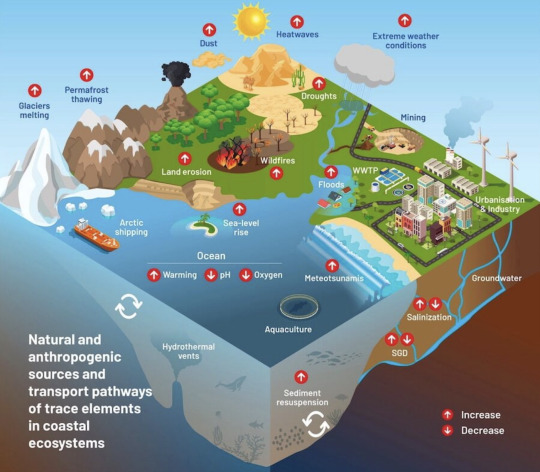#toxic substances
Explore tagged Tumblr posts
Text
The federal government is moving to add PFAS, a class of thousands of chemicals used in a wide range of products from food containers to clothing, to the official list of toxic substances, in light of growing scientific and public concern about the substances in Canada and around the world. PFAS, or per- and polyfluoroalkyl substances, are man-made chemicals used for their water and heat resistant properties. They are widely used in many everyday products — such as packaging, cosmetics and textiles — along with industrial uses like water-repellent coatings and firefighting foam.
Continue reading
Tagging: @newsfromstolenland
2K notes
·
View notes
Text

"La Porte city spokesperson Lee Woodward told KTRK-TV that they don’t yet know what flows through the pipeline or how it will be shut down. People in nearby schools were told to shelter in place as law enforcement blocked off a wide area."
source 1
source 2
source 3
#destiel meme news#destiel meme#news#united states#us news#pipeline#toxic substances#deadly fires#oil? gas? we don't know yet so i can't tag fully#hazardous materials#evacuation#houston#texas#la pointe#harris county#san jacinto#stay safe y'all#will update i guess as we know more
152 notes
·
View notes
Text

Illustration of natural and anthropogenic sources, sinks and transport pathways of trace substances in coastal ecosystems that may interact with climate impacts. Red arrows indicate expected directions of change due to climate change. Zitoun et al. 2024
Excerpt from this story from EcoWatch:
A new study is warning that trace metals like lead, arsenic and mercury that are present in ocean water can become more toxic over time as factors like ocean warming and acidity can increase the bioavailability of these trace elements.
Although these elements can naturally occur in coastal areas, their concentrations have increased due to human activities like agriculture and industrial manufacturing. Now, scientists warn that problems such as ocean acidification and warming are further strengthening the toxicity and spread of trace elements, both from natural and human sources.
“Human activities have increased the global flow of toxic metals such as lead by tenfold and mercury by three to seven times compared to pre-industrial levels,” Sylvia Sander, professor of marine mineral resources at GEOMAR, said in a statement. “Toxic elements like silver are increasingly detectable in coastal waters, originating from coal combustion and the growing use of silver nanoparticles in antibacterial products.”
The researchers found that the effects of rising sea levels, ocean warming, melting sea ice, drying river beds and ocean acidification could all play roles in the transport and accumulation of trace elements, particularly those that occur naturally. The researchers published their findings in the journal Communications Earth & Environment.
But trace elements from human sources are also contaminating the environment, with heavy metals coming into the oceans from fossil fuel and industry activities. Further, shipping and plastics can also introduce more trace elements into the oceans, especially because plastics can bind certain metals, including lead and copper.
As ocean temperatures rise, the bioavailability of trace elements increases, meaning it becomes easier for marine life to absorb the trace elements, the researchers explained. Trace elements, especially copper, also experience an increase in bioavailability and solubility in the presence of more acidic water. Copper can become extremely toxic to marine life in higher concentrations.
In a recent report on planetary vital signs, a team of international scientists confirmed that ocean warming and acidification had reached record extremes in recent years.
14 notes
·
View notes
Text
Europe’s Cruise Ships Produce Toxic Sulphur Emissions Equivalent to 1 Billion Cars
https://www.ecowatch.com/europe-cruise-ships-sulphur-emissions-air-pollution.html
#europe#fortress europe#cruise ship#cruise ships#pollution#co2 emissions#co2#toxic substances#sulphur#toxic#ausgov#politas#auspol#tasgov#taspol#australia#fuck neoliberals#neoliberal capitalism#anthony albanese#albanese government#pollutants#polluted air#polluters#polluted water#ecology#earth#science#environmental activism#environmental#environment
13 notes
·
View notes
Text
What you write, what you do, how you act; took no inspiration from what devours you, from what you despise most yet can't live without. Do not let it ruin what you hold dearest to you; for they had never had correlation.
#addiction#do NOT associate bad memories with good ones#live your life#happily.#poetic#poetry#literature#poems and poetry#creative writing#writing#poem#original poem#loz3rliterature#my poem#toxic substances#alcohol#smoking#trauma#mental illness#emotional abuse#isolation
8 notes
·
View notes
Photo

What Happens If You Mix Bleach and Vinegar?
#bleach#vinegar#cleaning tips#household chemistry#safety tips#chemical reactions#home experiments#toxic substances#health risks#midjourney#ai
0 notes
Text
🤮
1 note
·
View note
Text

#digitalart#female#sci-fi#mutation#art#toxic substances#woman#body modification#aiart#ai#skin condition
0 notes
Text
What are they cooking?
How does the cauldron soup glow cyan?
Don't drink that.

Ralsei and Robert are behind a cauldron. Ralsei is stirring the mixture inside the cauldron with a long wooden stick, while Robert is holding a white frosted cake with three strawberries on top. The room is dark, but their figures are illuminated by the neon cyan glow coming from within the cauldron.
commission for wasbeer tinkerer <3
520 notes
·
View notes
Text

#body modification#toxic substances#female#skin condition#sci-fi#woman#art#digitalart#mutation#ai#aiart
1 note
·
View note
Text

#digitalart#aiart#woman#female#art#biological anomaly#porous skin#ai#mutated#toxic substances#mutations
1 note
·
View note
Text
Child and Pet Safety: Navigating Choking Hazards and Toxic Substances
@ https://environmentalnote.com/.../chemicals-and-toxics/

Creating a safe environment for our children and pets is paramount in ensuring their wellbeing and peace of mind for ourselves. The home, a sanctuary for family and furry companions, can harbor unexpected dangers.
#toxin-free home#eco-friendly living#Environment#children#pets#choking hazard#toxins#toxic substances
0 notes
Text

#mutations#female#aiart#art#mutated woman#biological anomaly#digitalart#skin condition#toxic substances#woman#ai
0 notes
Text

#mutation#toxic substances#body modification#skin condition#digitalart#aiart#female#woman#sci-fi#art#ai
0 notes
Text

#digitalart#mutated woman#ai#woman#female#mutations#biological anomaly#toxic substances#skin condition#aiart#art
1 note
·
View note
Text
The 1985 Paraquat Poisonings: Japan's Unsolved Mystery of the Vending Machine Murderer
In 1985, Japan was gripped by a series of chilling and mysterious paraquat poisoning murders, a case that remains one of the country’s most enigmatic and disturbing unsolved crimes. Paraquat, a highly toxic herbicide known for its quick action and lethal potential, became the weapon of choice in a spate of indiscriminate killings that instilled widespread fear and paranoia across the nation. The…

View On WordPress
#1985 Japan#forensic investigation#Media Coverage#Paraquat Poisoning#Public Panic#Public Safety#Toxic Substances#Unsolved Mystery#Vending Machine
1 note
·
View note